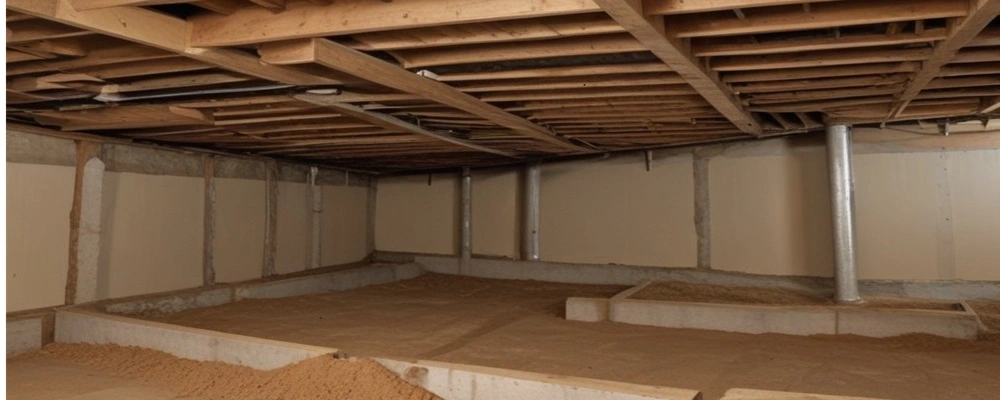The foundation is crucial to consider when starting a construction project or building your own house. Various types of foundations can be built according to the structure’s requirements, from deep foundations to shallow foundations. But, along with the other foundations, a crawl space foundation is a good option with several advantages for warmer regions.
In this post, Brick & Bolt will discuss the fundamentals and the interesting facts of a crawl space foundation, along with its types, advantages and disadvantages, and regular maintenance tips.
What is the Crawl Space Foundation?
A crawl space foundation is an elevated slab that separates the building’s base from the soil below. It usually rises between 1.5 and 3 feet high, giving workers adequate room to crawl through to reach services like electrical and plumbing systems. The footings, which are reinforced concrete pads that equally transmit the structure’s weight to the earth, support the foundation.
A crawl space foundation’s perimeter walls are built from treated timber, concrete blocks, or poured concrete. These walls act as a barrier against pests and dampness and provide structural support. To provide stability, they are often joined to the footings and strengthened with steel bars.
Installing insulation and a vapour barrier is essential to a crawl space foundation. The vapour barrier, often composed of polyethylene, aids in keeping the crawl area dry. To form a closed space, it is set on the ground and fastened to the outside walls. Additionally, insulation is placed beneath the flooring and on the perimeter walls to increase energy efficiency and reduce temperature swings. In addition to these elements, a crawl space foundation also needs adequate ventilation and moisture management. If a region has a lot of rainfall or high groundwater, additional measures to regulate moisture levels might be implemented, such as a sump pump or a dehumidifier.
Interesting Facts About Crawl Space Foundation
Warmer areas are more likely to have crawl space foundations when there is no frost line on the ground around the house’s base. Crawl space foundations were used in older buildings. They didn’t have many things back then, so this was the best way to keep a house stable. Also, crawl space supports are sometimes only used for storage, not living.
Types of Crawl Space Foundations
The following are the types of crawl space foundations:
Block and Base Crawl Space Foundation
The name of this kind of crawl space foundation accurately describes it. Around the base of the house, blocks are piled up like piers. Additionally, the house supports may be seen as beams made of wood, stone, or brick, leaving the outside of the house unfinished or without any decorative border.
Pier and Beam Crawl Space Foundation
The crawl space foundation style entails installing brick or blocks into the soil around the whole perimeter of the house. It contains vents to prevent moisture accumulation in the airflow underneath the house.
Advantages and Disadvantages of Crawl Space Foundation
Like the other foundation types, crawl space foundations offer both builders and homeowners benefits and drawbacks.
Advantages of Crawl Space Foundations
- It may be simpler to build a house.
- Simple access to house systems, such as electrical and plumbing, for maintenance.
- Because of its elevation, there is less risk of floods.
- The wood utilized for the floor and foundation is good for human health.
- Generally, home levelling and foundation restoration are less expensive.
- The house is elevated to provide pleasant views of the backyard.
Disadvantages of Crawl Space Foundations
- Unlike basement houses, under-home leaks are more likely to be undetected.
- This home foundation doesn’t have an aesthetically appealing appearance.
- Homes with crawl spaces need constant maintenance.
- It is not recommended for very sloping lots or cold, frost-line climates.
- Higher probability of musty odours, mold or mildew, and drainage issues.
- They are lightweight and more likely to move in large amounts of dirt and strong winds.
- Some believe they are old-school and inferior to newer forms of foundations.
Maintenance Tips for Crawl Space Foundation Maintenance
The following are places that should get routine repairs:
- Drying out the crawl area is one of them. To do this, you will need a drainage system, vapour barrier, dehumidifier, and wet vacuum.
- Crawl space cleaning is another area. Sadly, dust may accumulate here more quickly! There will be leaks, mold, debris, and pests all over it. To reduce the humidity, you may need to seal the crawl area and use a specialized vacuum cleaner.
- If you want a structurally sound, low-maintenance home, you must ensure the foundation is in excellent shape.
Conclusion
In conclusion, choosing the right foundation is crucial when you build a home. So, understanding the fundamentals of a crawl space foundation is essential for anyone starting your project. This type of foundation offers several benefits, especially in warmer regions, including easier access to plumbing and electrical systems and reduced flood risk. However, it also requires regular maintenance to manage moisture and prevent mold. You can ensure a stable and efficient foundation for your home by following proper installation and maintenance tips. However, it is recommended to consult an experienced professional like Brick & Bolt before deciding on the foundation for your home. Our skilled architects and engineers will guide you through the process and provide a high-quality construction service. In addition, you can also calculate your construction cost using a cost estimator for free.

